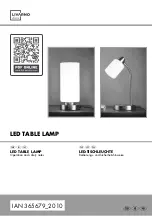
24
10. Mounting and connection
Pay attention to the information in the "Preparation for mounting" section.
Ensure that no existing cables or pipes (including water pipes) are damaged when drilling
mounting holes or securing screws.
a) Securing the control unit
1. When mounting the control unit (2), ensure that a mains plug is within a suitable distance.
2.
Use the control unit as a template to mark the fixing points on the surface.
3. Secure the control unit to a suitable surface (wood, plastic or thin metal sheet) by screwing the
screws (1) through the ready-made holes. You may need to drill a hole of a sufficient size for very hard
types of these materials. For short-term or mobile use, you can also hang the control unit on the screw
holes with a piece of thread, or place it on a surface and weigh it down with an object. Alternatively, you
can also secure the bottom of the control unit using wide, double-sided adhesive tape (8).
When mounting the control unit, always ensure that the infra-red sensor (3) on the IR remote
control (6) is not obstructed so that it can control the light effects of the LED strip (7) remotely.
b) Securing the LED strip
The conductors must not be damaged or interrupted when mounting the LED strip!
When mounting the LED strip on metal surfaces, the mounting surface should be isolated from
the LED strip (7) to prevent short circuits on exposed solder contacts.
Take precautions against electrostatic discharge (ESD) when mounting the product.
1. The LED strip can be mounted using the adhesive tape on the rear of the strip (8). Start by mounting the
LED strip at one end.
2.
Peel off approximately 30 cm of protective film on the back of the LED strip.
3.
Affix the LED strip to the mounting surface. Ensure that you secure the LED strip to a clean surface that
is free from grease, oil, silicon and dirt particles.
4. Repeat this step bit by bit until the LED strip is fully secure.
WARNING: Do not bend the LED strip! This can damage the soldered joints.
5. To bridge exposed parts without a mounting surface (or for decorative purposes), you can dismantle the
LED strip into smaller parts and connect up to five connection cables (12) to each other.
6. To do so, separate the LED strip at the marked points using a pair of scissors, a wire cutter or other
similar tool. Alternatively, use a box cutter to score along each side of the marked separation points and
then carefully separate the LED strip.
















































